Sir John Monash - Personal Files Book 2, 1 April - 11 April 1915, Part 2
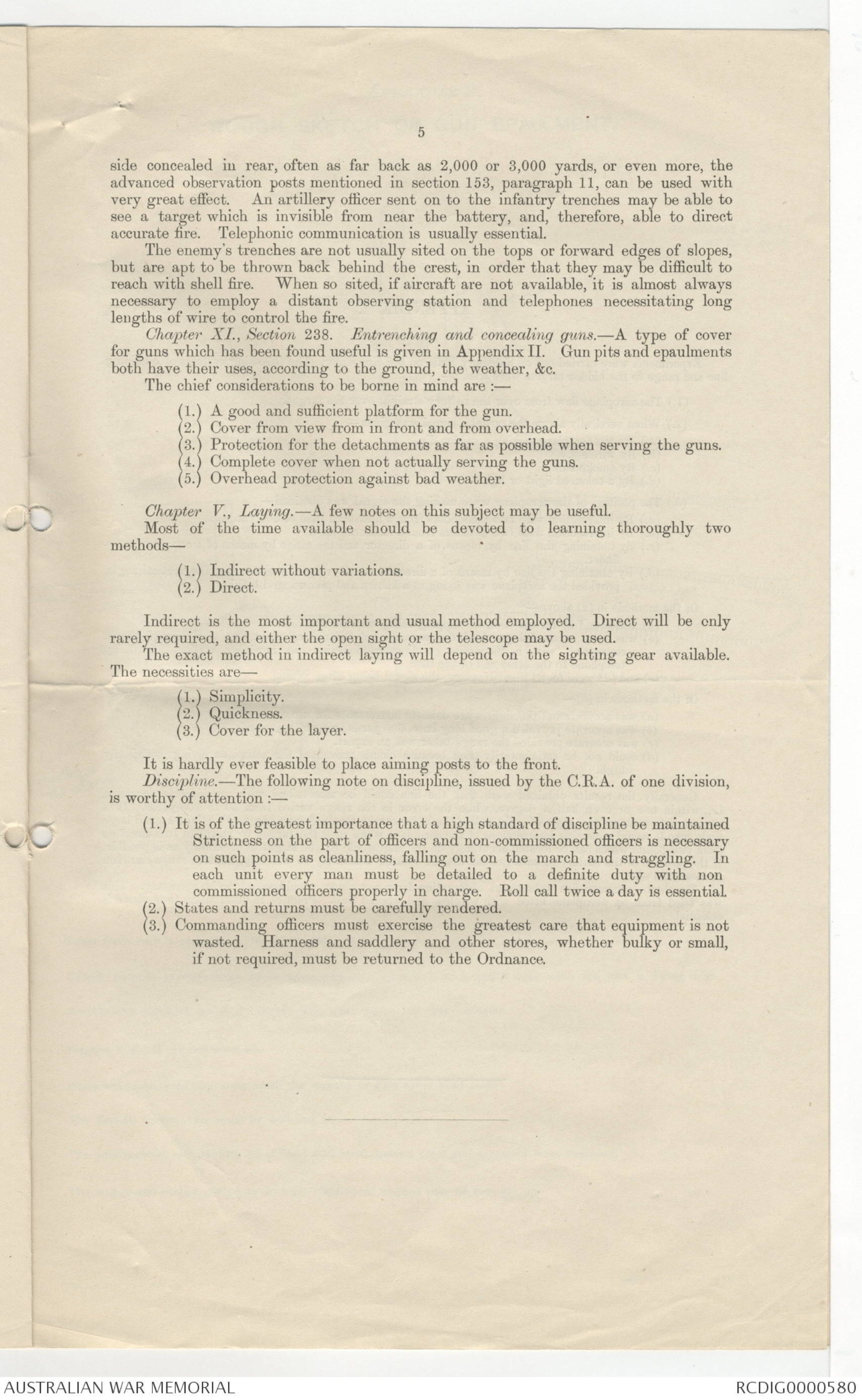
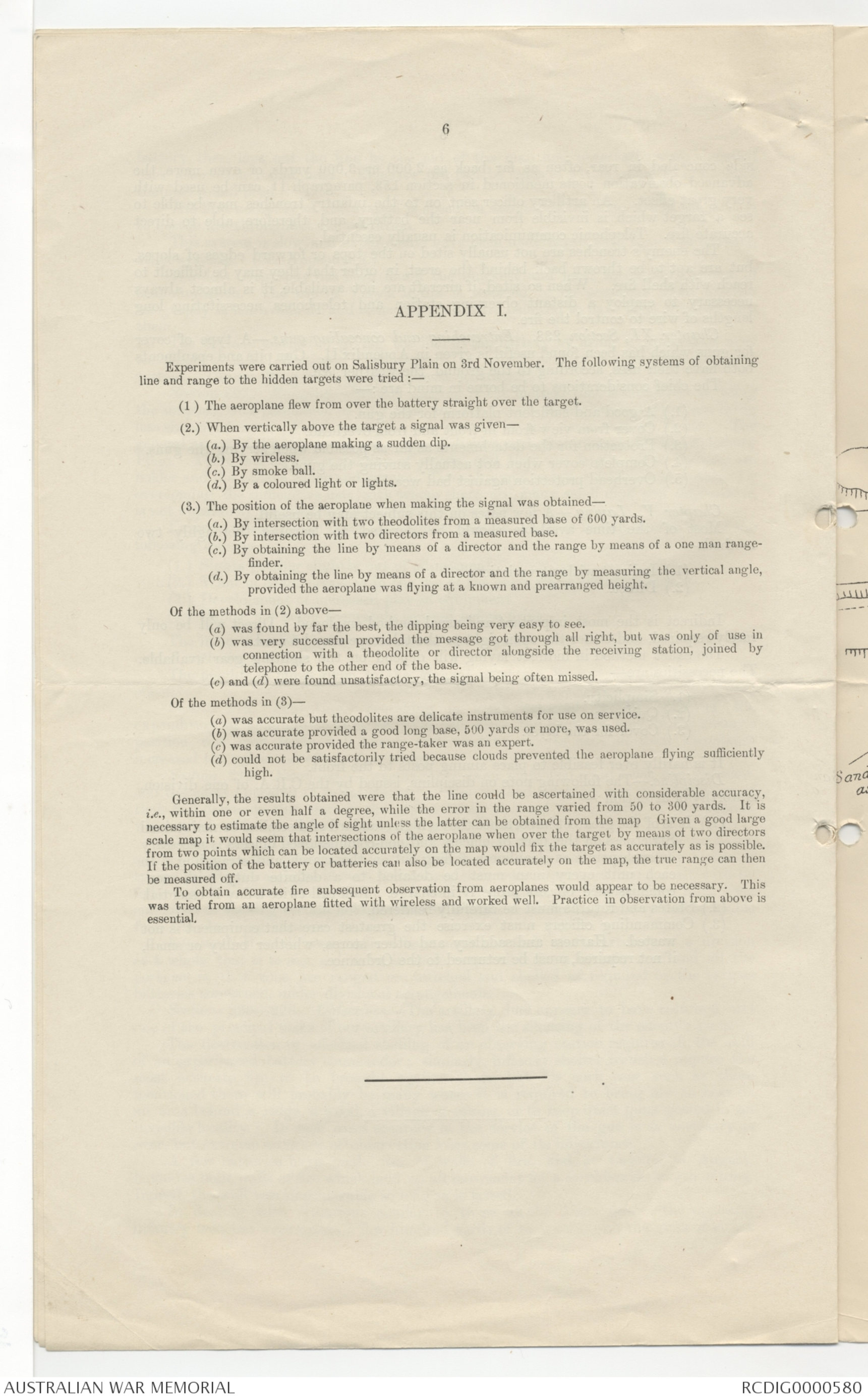
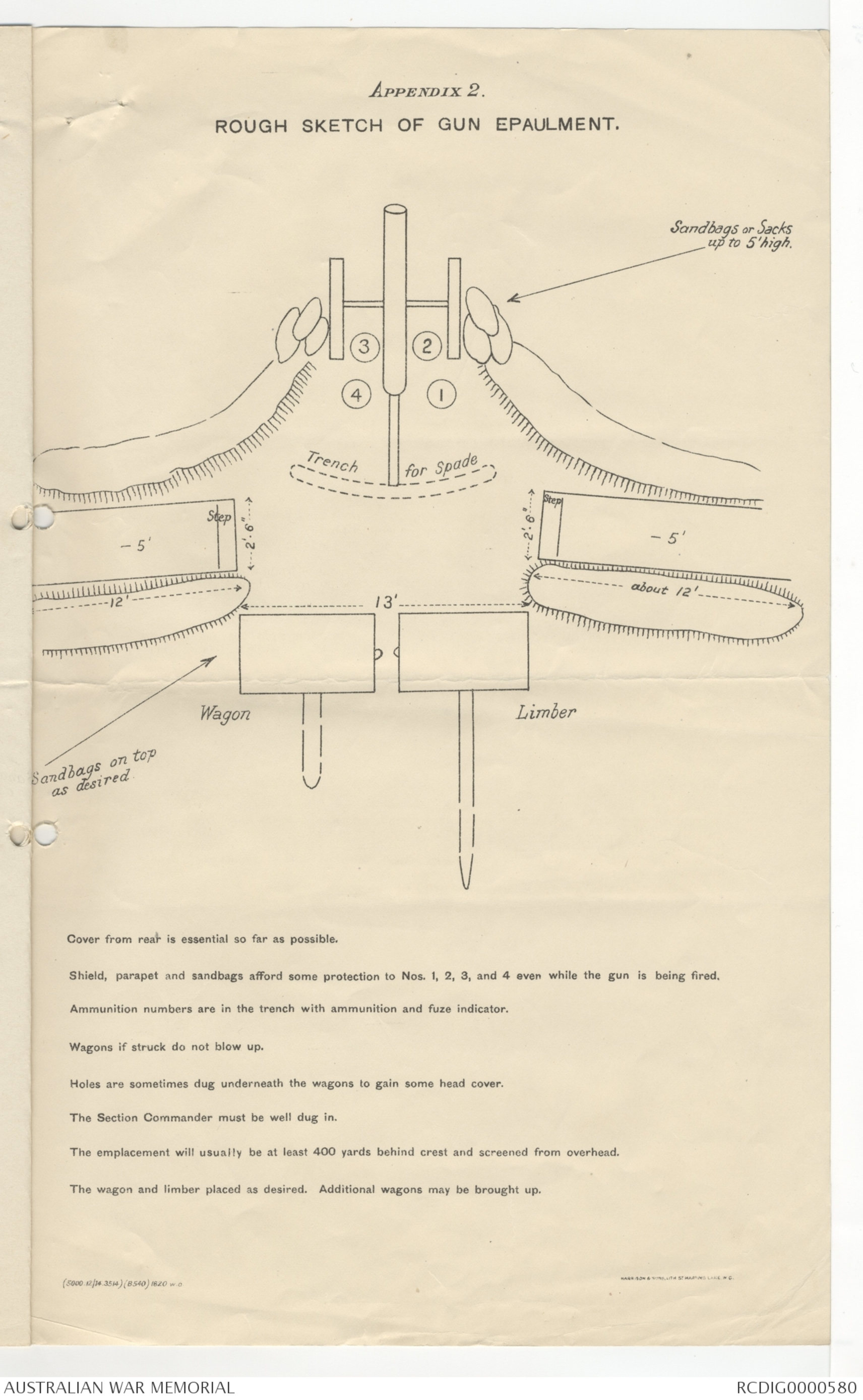
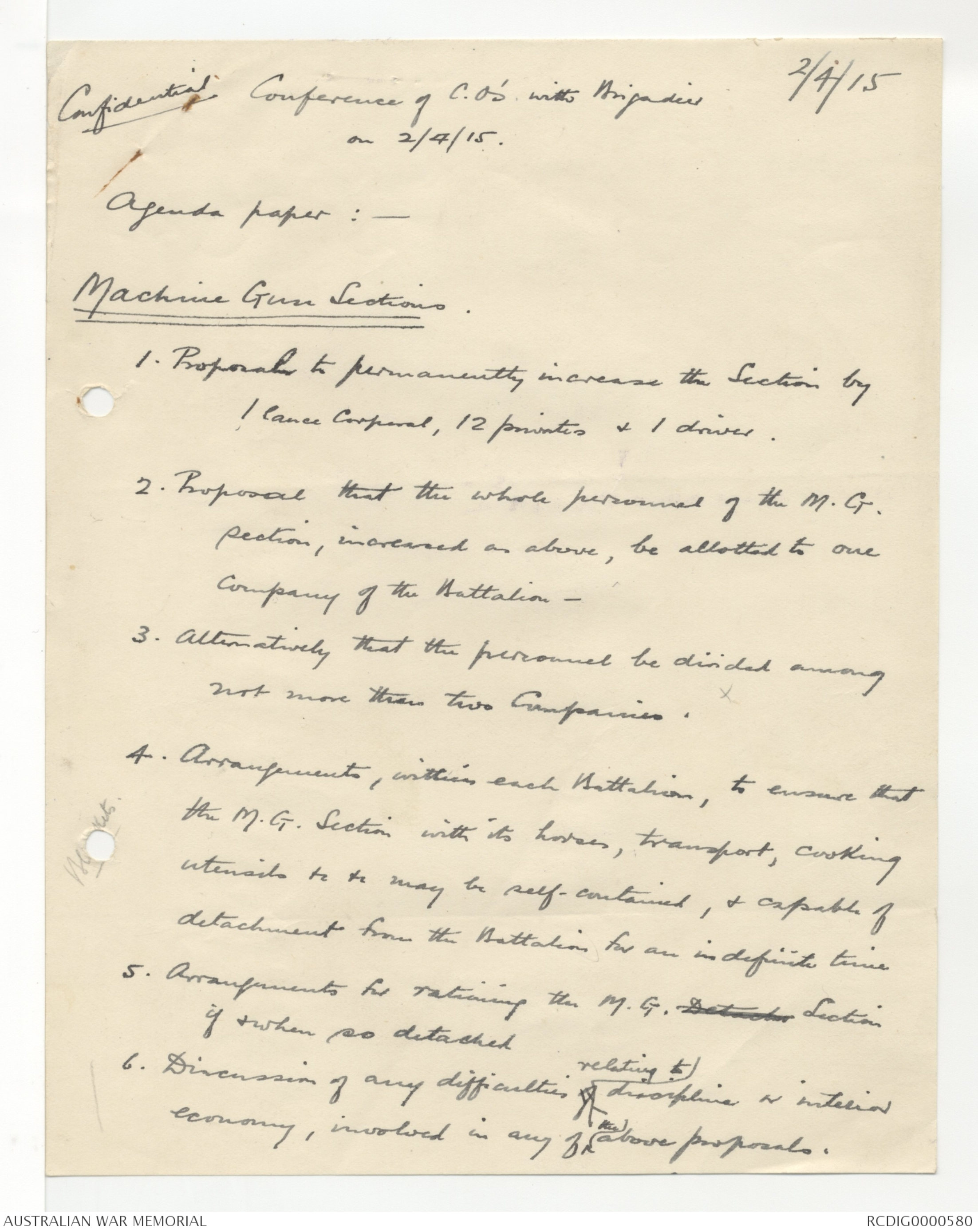
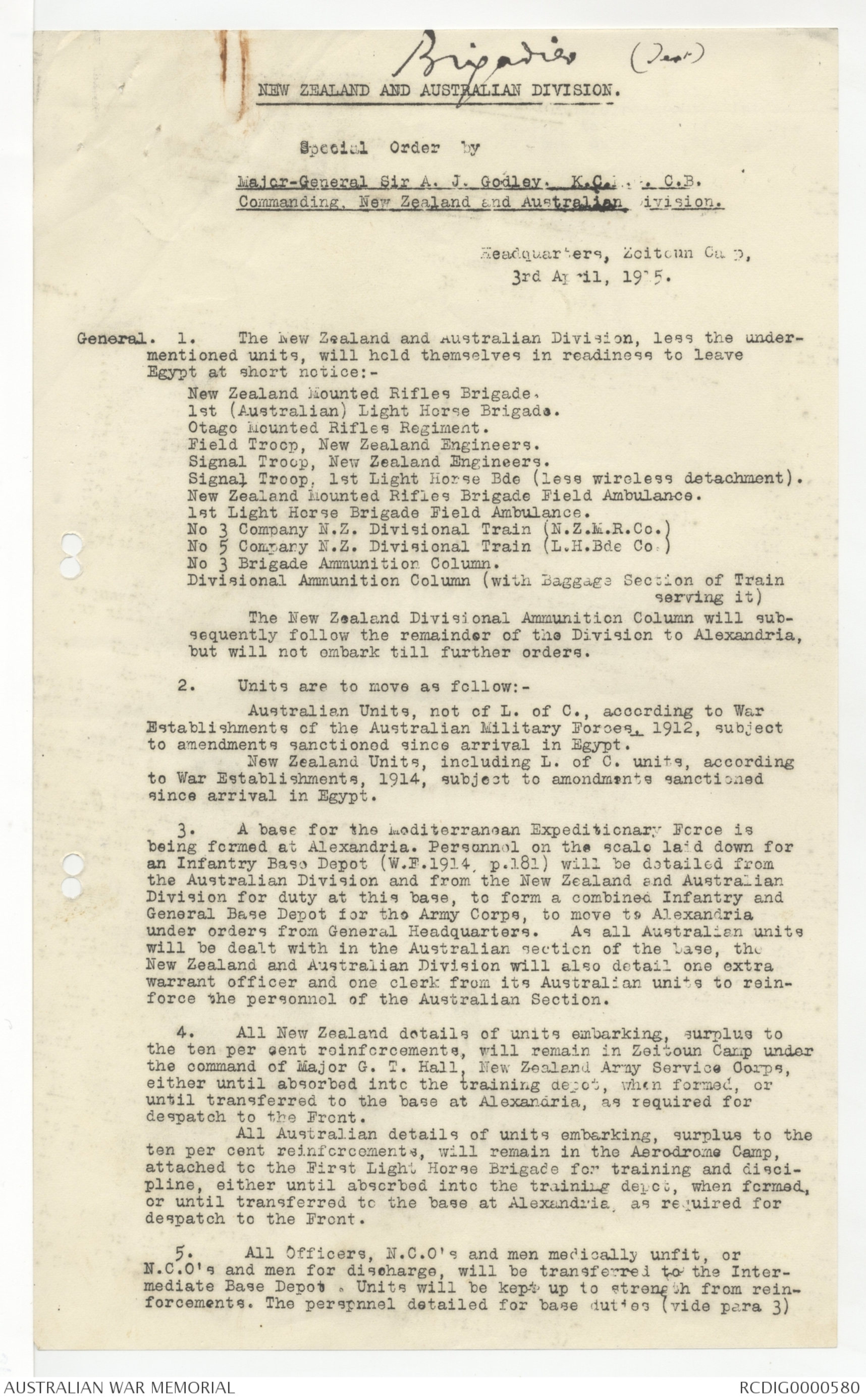
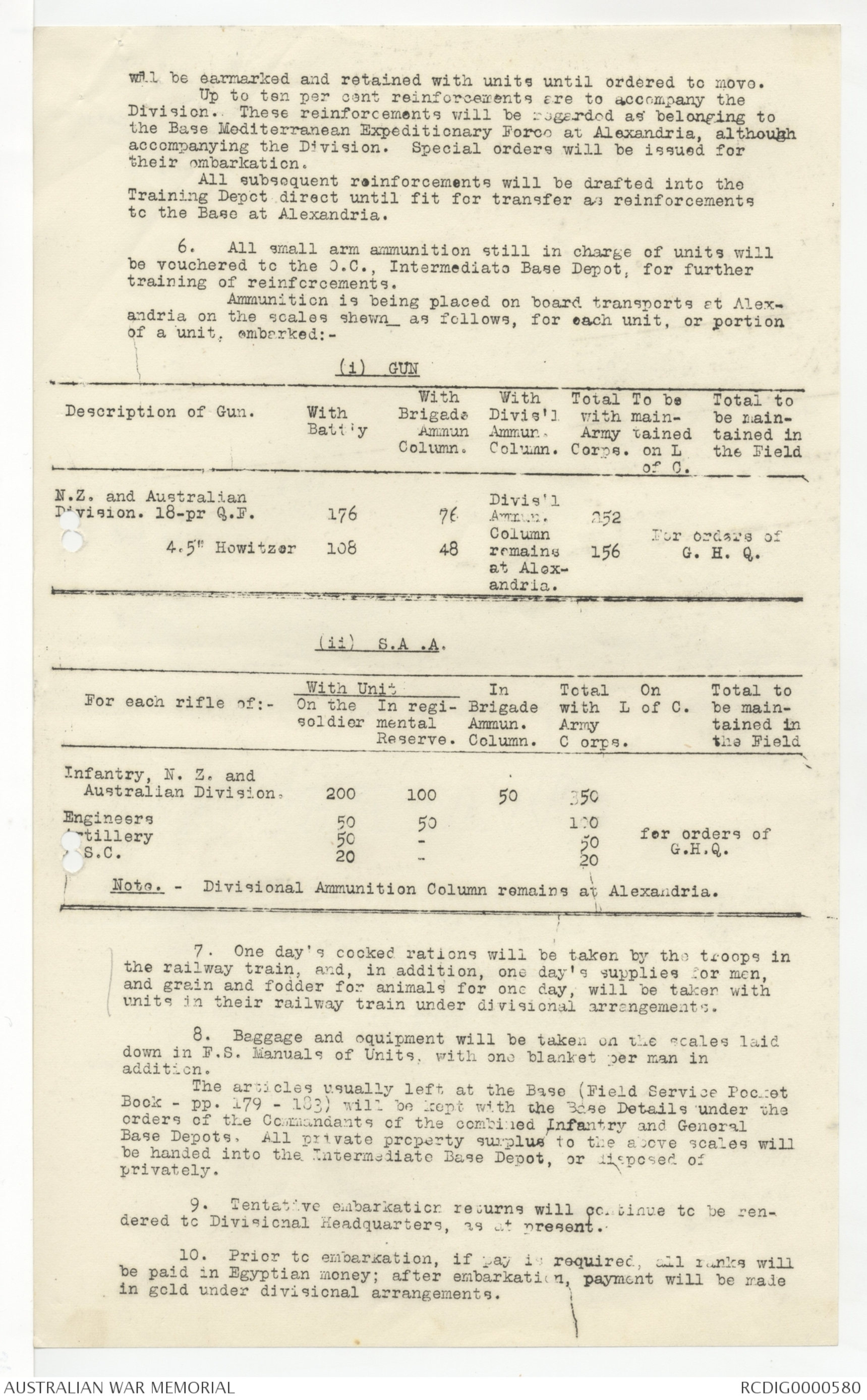
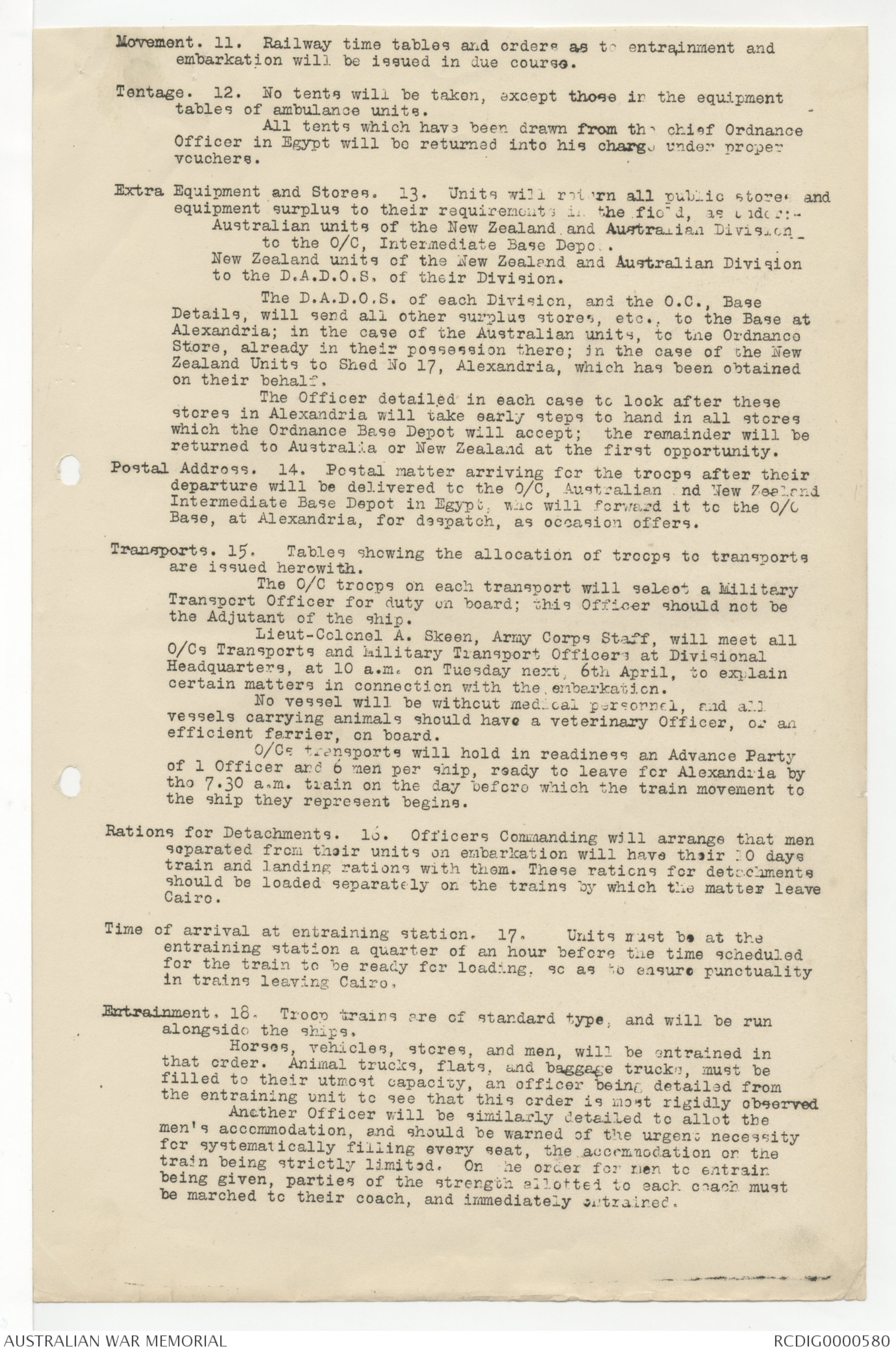
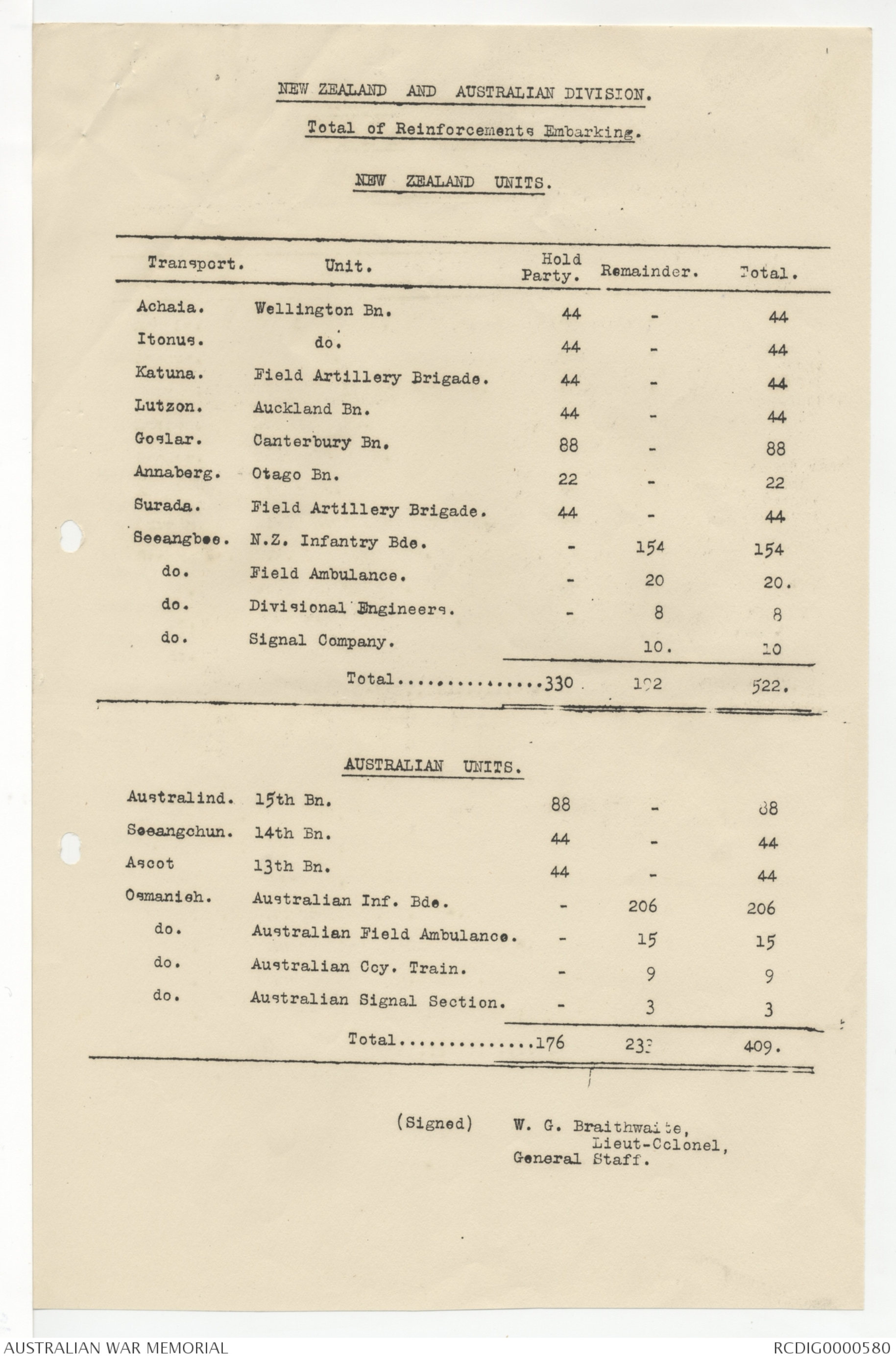
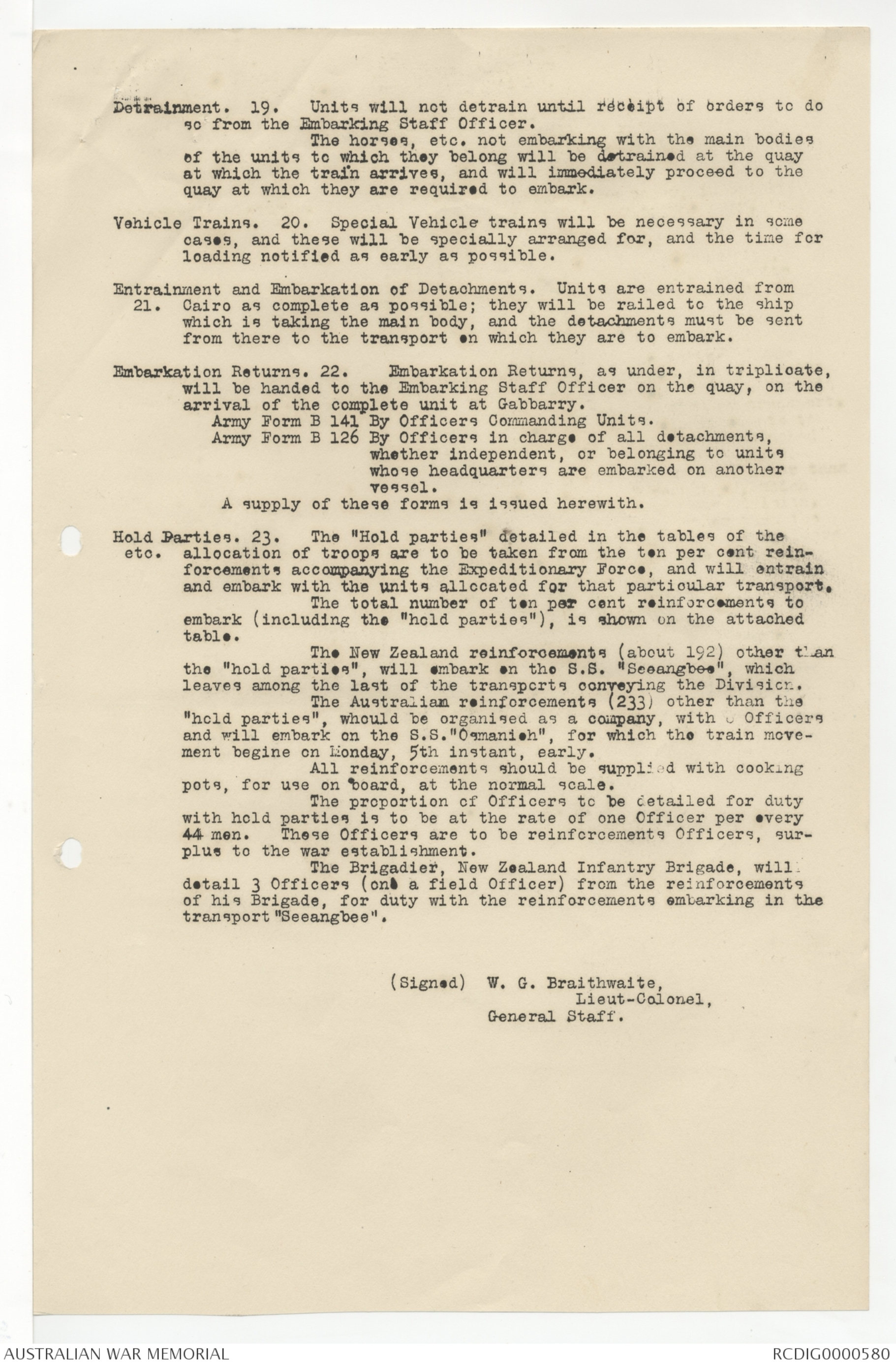
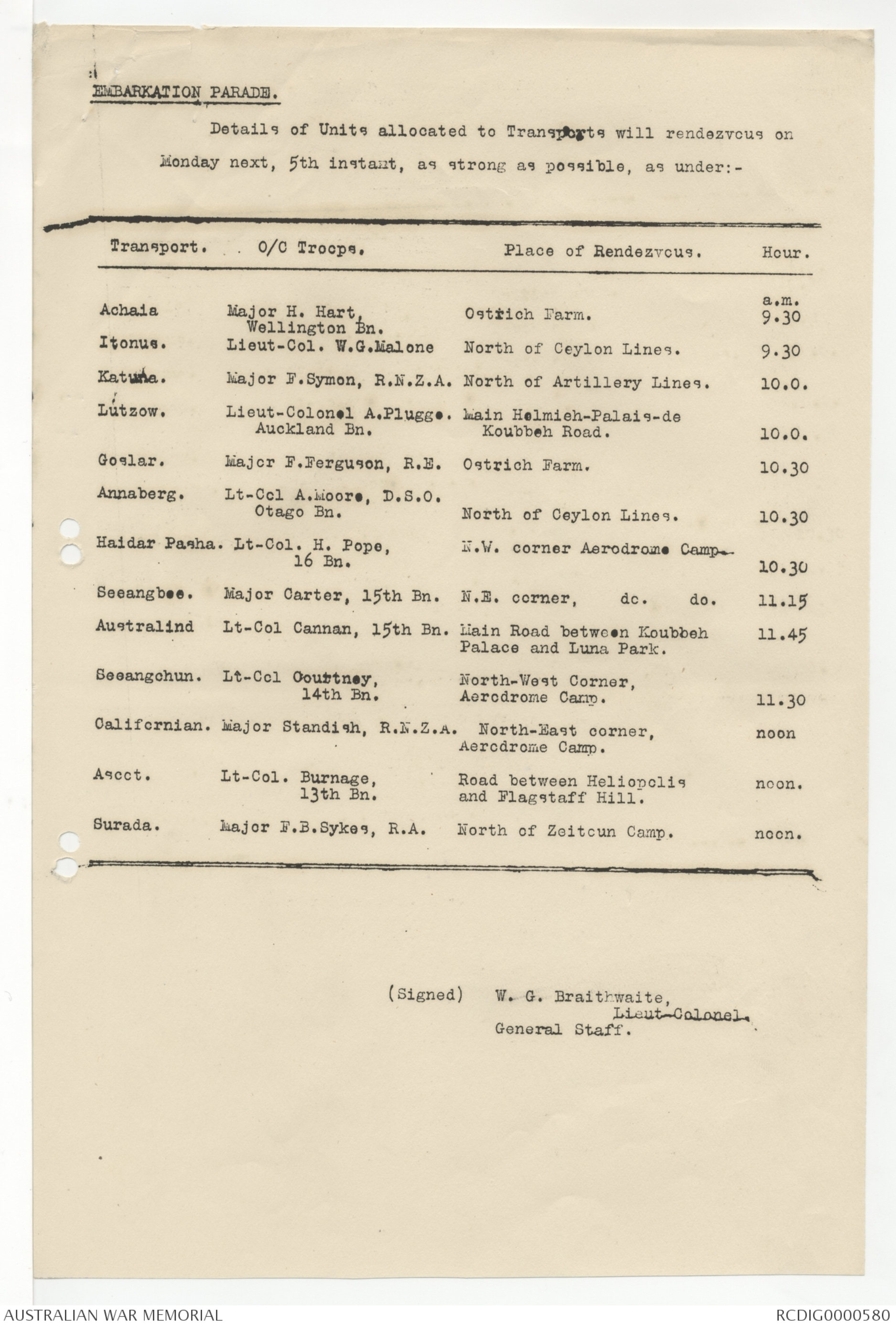
5
side concealed in rear, often as far back as 2,000 or 3,000 yards, or even more, the
advanced observation posts mentions in section 153, paragraph 11, can be used with
very great effect. An artillery officer sent on to the infantry trenches may be able to
see a target which is invisible from near the battery, and, therefore, able to direct
accurate fire. Telephonic communication is usually essential.
The enemy's trenches are not usually sited on the tops or forward edges of slopes,
but are apt to be thrown back behind the crest, in order that they may be difficult to
reach with shell fire. When so sited, if aircraft are not available, it is almost always
necessary to employ a distant observing station and telephones necessitating long
lengths of wire to control the fire.
Chapter XI., Section 238. Entrenching and concealing guns.-A type of cover
for guns which has been found useful is given in Appendix II. Gun pits and epaulments
both have their uses, according to the ground, the weather, &c.
The chief considerations to be borne in mind are :-
(1.) A good and sufficient platform for the gun.
(2.) Cover from view from in front and from overhead.
(3.) Protection for the detachments as far as possible when serving the guns.
(4.) Complete cover when not actually serving the guns.
(5.) Overhead protection against bad weather.
Chapter V., Laying. -A few notes on this subject may be useful.
Most of the time available should be devoted to learning thoroughly two
methods-
(1.) Indirect without variations.
(2.) Direct.
Indirect is the most important and usual method employed. Direct will be only
rarely required, and either the open sight or the telescope may be used.
The exact method in indirect laying will depend on the sighting gear available.
The necessities are-
(1.) Simplicity.
(2.) Quickness.
(3). Cover for the layer.
It is hardly ever feasible to place aiming posts to the front.
Discipline.-The following note on discipline, issued by the C.R.A. of one division,
is worthy of attention :-
(1.) It is of the greatest importance that a high standard of discipline be maintained
Strictness on the part of the officers and non-commissioned officers is necessary
on such points as cleanliness, falling out on the march and straggling. In
each unit every man must be detailed to a definite duty with non
commissioned officers properly in charge. Roll call twice a day is essential.
(2.) States and returns must be carefully rendered.
(3.) Commanding officers must exercise the greatest care that equipment is not
wasted. Harness and saddlery and other stores, whether bulky or small,
if not required, must be returned to the Ordnance.
6 APPENDIX I.
Experiments were carried out on Salisbury Plain on 3rd November. The following systems of obtaining line and range to the hidden targets were tried :-
(1) The aeroplane flew over the battery straight over the target.
(2.) When vertically above the target a signal was given-
(a.) By the aeroplane making a sudden dip.
(b.) By wireless.
(c.) By smoke ball.
(d.) By a coloured light or lights.
(3.) The position of the aeroplane when making the signal was obtained-
(a.) By intersection with two theodolites from a measure base of 600 yards.
(b.) By intersection with two directors from a measured base.
(c.) By obtaining the line by means of a director and the range by means of a one man range-finder.
(d.) By obtaining the line by means of a director and the range by measuring the vertical angle, provided the aeroplane was flying at a known and prearranged height.
Of the methods in (2) above-
(a) was found by far the best, the dipping being very easy to see.
(b) was very successful provided the message got through all right, but was only of use in connection with a theodolite or director alongside the receiving station, joined by telephone to the other end of the base.
(c) and (d) were found unsatisfactory, the signal being often missed.
Of the methods in (3)-
(a) was accurate but theodolites are delicate instruments for use on service.
(b) was accurate provided a good long base, 500 yards or more, was used.
(c) was accurate provided the range-taker was an expert.
(d) could not be satisfactorily tried because clouds prevented the aeroplane flying sufficiently high.
Generally, the results obtained were that the line could be ascertained with considerable accuracy, i.e., within one or even half a degree, while the error in the range varied from 50 to 300 yards. It is necessary to estimate the angle of sight unless the latter can be obtained from the map Given a good large scale map it would seem that intersections of aeroplane when over the target by means of two directors from two points which can be located accurately on the map would fix the target as accurately as is possible. If the position of the battery or batteries can also be located accurately on the map, the true range can then be measured off.
To obtain accurate fire subsequent observation from aeroplanes would appear to be necessary. This was tried from an aeroplane fitted with wireless and worked well. Practice in observation from above is essential.
APPENDIX 2.
ROUGH SKETCH OF GUN EPAULMENT.
Cover from rear is essential so far as possible.
Shield, parapet and sandbags afford some protection to Nos. 1, 2, 3 and 4 even while the gun is being fired.
Ammunition numbers are in the trench with ammunition and fuze indicator.
Wagons if struck do not blow up.
Holes are sometimes dug underneath the wagons to gain some head cover.
The Section Commander must be well dug in.
The emplacement will usually be at least 400 yards behind crest and screened from overhead.
The wagon and limber placed as desired. Additional wagons may be brought up.
[[5000?]] [[?]]
Confidential
2/4/15
Conference of C.O’s with Brigadiers on 2/4/15.
Agenda paper :-
Machine Gun Sections.
- Proposal to permanently increase the Section by
1 lance Corporal, 12 privates & 1 driver. - Proposal that the whole personnel of the M.G.
Section, increased as above, be allotted to one
company of the Battalion- - Alternatively that the personnel be divided among
not more than two Companies. - Arrangements, within each Battalion, to ensure that
the M.G. Section with its horses, transport, cooking
utensils &c &c may be self-contained, & capable of
detachment from the Battalion for an indefinite time - Arrangements for rationing the M.G.
DetachmSection
if & when so detached - Discussion of any difficulties relating to discipline or interior
economy, involved in any of the above proposals.
*Brigadier* [[?]]
NEW ZEALAND AND AUSTRALIAN DIVISION.
Special Order by
Major-General Sir A. J. Godley. K. C.[[?]] . C.B.
Commanding, New Zealand and Australian Division.
Headquarters, Zeitoun Camp,
3rd April, 1915.
General. 1. The New Zealand and Australian Division, less the undermentioned
units, will hold themselves in readiness to leave
Egypt at short notice:-
New Zealand Mounted Rifles Brigade.
1st (Australian) Light Horse Brigade.
Otago Mounted Rifles Regiment.
Field Troop, New Zealand Engineers.
Signal Troop, New Zealand Engineers.
Signal Troop, 1st Light Horse Bde (less wireless detachment).
New Zealand Mounted Rifles Brigade Field Ambulance.
1st Light Horse Brigade Field Ambulance.
No 3 Company N.Z. Divisional Train (N.Z.M.R.Co.)
No 5 Company N.Z. Divisional Train (L.H.Bde Co.)
No 3 Brigade Ammunition Column.
Divisional Ammunition Column (with Baggage section of Train
serving it)
The New Zealand Divisional Ammunition Column will subsequently
follow the remainder of the Division to Alexandria,
but will not embark till further orders.
2. Units are to move as follow:-
Australian Units, not of L. of C., according to War
establishments of the Australian Military Forces, 1912, subject
to amendments sanctioned since arrival in Egypt.
New Zealand Units, including L. of C. units, according
to War Establishments, 1914, subject to amendments sanctioned
since arrival in Egypt.
3. A base for the Mediterranean Expeditionary Force is
being formed at Alexandria. Personnel on the scale laid down for
an Infantry Base Depot (W.F.1914, p.181) will be detailed from
the Australian Division and from the New Zealand and Australian
Division for duty at this base, to form a combined Infantry and
General Base Depot for the Army Corps, to move to Alexandria
under orders from General Headquarters. As all Australian units
will be dealt with in the Australian section of the base, the
New Zealand and Australian Division will also detail one extra
warrant officer and one clerk from its Australian units to reinforce
the personnel of the Australian Section.
4. All New Zealand details of units embarking, surplus to
the ten per cent reinforcements, will remain in Zeitoun Camp under
the command of Major G. T. Hall, New Zealand Army Service Corps,
either until absorbed into the training depot, when formed, or
until transferred to the base at Alexandria, as required for
despatch to the Front.
All Australian details of units embarking, surplus to the
ten per cent reinforcements, will remain in the Aerodrome Camp,
attached to the First Light Horse Brigade for training and discipline,
either until absorbed into the training depot, when formed,
or until transferred to the base at Alexandria, as required for
despatch to the Front.
5. All officers, N.C.O's and men medically unfit, or
N.C.O's and men for discharge, will be transferred to the Intermediate
Base Depot. Units will be kept up to strength from reinforcements.
The personnel detailed for base duties (vide para 3)
will be earmarked and retained with units until ordered to move.
Up to ten per cent reinforcements are to accompany the
Division. These reinforcements will be regarded as belonging to
the Base Mediterranean Expeditionary Force at Alexandria, although
accompanying the Division. Special orders will be issued for
the embarkation.
All subsequent reinforcements will be drafted into the
Training Depot direct until fit for transfer as reinforcements
to the Base at Alexandria.
6. All small arm ammunition still in charge of units will
be vouchered to the O.C., Intermediate Base Depot, for further
training and reinforcements.
Ammunition is being placed on board transports at Alexandria
on the scales shewn_ as follows, for each unit, or portion
of a unit, embarked:-
|
(i) GUN |
||||||
| Description of Gun. | With Batt'y | With Brigade Ammun Column. | With Divis'l Ammun Column. | Total with Army Corps. | To be maintained on L of C. | Total to be maintained in the Field |
| N.Z. and Australian Division. 18-pr Q.F. 4.5" Howitzer |
176 108 |
76 48 |
Divis'l Ammun. Column remains at Alexandria. | 252 156 |
For orders of G. H. Q. | |
|
(ii) S.A .A. |
||||||
| With Unit | ||||||
| For each rifle of:- | On the soldier |
In regimental Reserve. | In Brigade Ammun. Column. | Total with Army Corps. | On L of C. | Total to be maintained in the Field |
| Infantry, N. Z. and Australian Division. Engineers Artillery O.S.C. |
200 50 50 20 |
100 50 - - |
50 |
350 100 50 20 |
for orders of G. H. Q. | |
| Note. - Divisional Ammunition Column remains in Alexandria. | ||||||
7. One day's cooked rations will be taken by the troops
in the railway train, and, bin addition, one day's supplies for men,
and grain and fodder for animals for one day, will be taken with
unit in their railway train under divisional arrangements.
8. Baggage and equipment will be taken on the scales laid
down in F.S. Manuals of Units, with one blanket per man in
addition.
The articles usually left at the Base (Field Service Pocket
Book - pp. 179 - 183) will be kept with the Base Details under the
orders of the Commandants of the combined Infantry and General
Base Depots. All private property surplus to the above scales
will be handed into the Intermediate Base Depot, or disposed of
privately.
9. Tentative embarkation returns will continue to be rendered
to the Divisional Headquarters, as at present.
10. Prior to embarkation, if pay is required, all ranks will
be paid in Egyptian money; after embarkation, payment will be made
in gold under divisional arrangements.
Movement. 11. Railway time tables and orders as to entrainment and
embarkation will be issued in due course.
Tentage. 12. No tents will be taken, except those in the equipment
tables of ambulance units.
All tents which have been drawn from the chief Ordnance
Officer in Egypt will be returned into his charge under proper vouchers.
Extra Equipment and Stores. 13. Units will return all public stores and
equipment surplus to their requirements in the field, as under:-
Australian units of the New Zealand and Australian Division
to the O/C, Intermediate Base Depot.
New Zealand units of the New Zealand and Australian Division
to the D.A.D.O.S. of their Division.
The D.A.D.O.S. of each Division, and the O.C., Base
Details, will send all other surplus stores, etc., to the Base at
Alexandria; in the case of the Australian units, to the Ordnance
Store, already in their possession there; in the case of the New
Zealand Units to Shed No 17, Alexandria, which has been obtained
on their behalf.
The Officer detailed in each case to look after these
stores in Alexandria will take early steps to hand in all stores
which the Ordnance Base Depot will accept; the remainder will be
returned to Australia or New Zealand at the first opportunity.
Postal Address. 14. Postal matters arriving for the troops after their
departure will be delivered to the O/C, Australian and New Zealand
Intermediate Base Depot in Egypt, who will forward it to the O/C
Base, at Alexandria, for despatch, as occasion offers.
Transports. 15. Tables showing the allocation of troops to transports
are issued herewith.
The O/C troops on each transport will select a Military
Transport Officer for duty on board; this Officer should not be
the Adjutant of the ship.
Lieut-Colonel A. Skeen, Army Corps Staff, will meet all
O/Cs Transports and Military Transport Officers at Divisional
Headquarters, at 10 a.m. on Tuesday next, 6th April, to explain
certain matters in connection with the embarkation.
No vessel will be without medical personnel, and all
vessels carrying animals should have a veterinary Officer, or an
efficient farrier, on board.
O/Cs transports will hold in readiness an Advance Party
of 1 Officer and 6 men per ship, ready to leave for Alexandria by
the 7.30 a.m. train on the day before which the train movement to
the ship they represent begins.
Rations for Detachments. 16. Officers Commanding will arrange that men
separated from their units on embarkation will have their 10 days
train and landing rations with them. These rations for detachments
should be loaded separately on the trains by which the matter leave
Cairo.
Time of arrival at entraining station. 17. Units must be at the
entraining station a quarter of an hour before the time scheduled
for the train to be ready for loading, so as to ensure punctuality
in trains leaving Cairo.
Entrainment. 18. Troop trains are of a standard type, and will be run
alongside the ships.
Horses, vehicles, stores, and men, will be entrained in
that order. Animal trucks, flats, and baggage trucks, must be
filled to their utmost capacity, an officer being detailed from
the entraining units to see that this order is most rigidly observed.
Another Officer will be similarly detailed to allot the
men's accommodation, and should be warned of the urgent necessity
for systematically filling every seat, the accommodation on the
train being strictly limited. On the order for men to entrain
being given, parties of the strength allotted to each coach must
be marched to their coach, and immediately entrained.
NEW ZEALAND AND AUSTRALIAN DIVISION.
Total of Reinforcements Embarking.
NEW ZEALAND UNITS.
| Transport. | Unit. | Hold Party. | Remainder. | Total. |
| Achaia. | Wellington Bn. |
44 |
- |
44 |
| Itonus. | do. |
44 |
- |
44 |
| Katuna. | Field Artillery Brigade. |
44 |
- |
44 |
| Lutzon. | Auckland Bn, |
44 |
- |
44 |
| Goslar. | Canterbury Bn. |
88 |
- |
88 |
| Annaberg. | Otago Bn. |
22 |
- |
22 |
| Surada. | Field Artillery Brigade. |
44 |
- |
44 |
| Seeangbee. | N.Z.Infantry Bde. |
- |
154 |
154 |
| do. | Field Ambulance. |
- |
20 |
20. |
| do. | Divisional Engineers. |
- |
8 |
8 |
| do. | Signal Company. |
|
10. |
10 |
|
Total.......... |
330 |
192 |
522. |
AUSTRALIAN UNITS.
| Australind. | 15th Bn. | 88 | - | 88 |
| Seeangchun. | 14th Bn. | 44 | - | 44 |
| Ascot. | 13th Bn. | 44 | - | 44 |
| Osmanish. | Australian Inf. Bde. | - | 206 | 206 |
| do. | Australian Field Ambulance. | - | 15 | 15 |
| do. | Australian Coy. Train. | - | 9 | - |
| do. | Australian Signal Section. | - | 3 | 3 |
|
Total.......... |
176 | 233 | 409. |
(Signed) W. G. Braithwaite,
Lieut-Colonel,
General Staff.
Detrainment. 19. Units will not detrain until receipt of orders to do
so from the Embarking Staff Officer.
The horses, etc. not embarking with the main bodies
of the units to which they belong will be detrained at the quay
at which the train arrives, and will immediately proceed to the
quay at which they are required to embark.
Vehicle Trains. 20. Special vehicle trains will be necessary in some
cases, and these will be specially arranged for, and the time for
loading notified as early as possible.
Entrainment and Embarkation of Detachments. Units are entrained from
21. Cairo as complete as possible; they will be railed to the ship
which is taking the main body, and the detachments must be sent
from there to the transport on which they are to embark.
Embarkation Returns. 22. Embarkation Returns, as under, in triplicate,
will be handed to the Embarking Staff Officer on the quay, on the
arrival of the complete unit at Gabbarry.
Army Form B 141 By Officers Commanding Units.
Army Form B 126 By Officers in charge of all detachments,
whether independent, or belonging to units
whose headquarters are embarked on another
vessel.
A supply of these forms in issued herewith.
Hold Parties etc. 23. The "Hold Parties" detailed in the tables of the
allocation of troops are to be taken from the ten per cent reinforcements
accompanying the Expeditionary Force, and will entrain
and embark with the units allocated for that particular transport.
The total number of ten per cent reinforcements to
embark (including the "hold parties"), is shown on the attached
table.
The New Zealand reinforcements (about 192) other than
the "hold parties", will embark on the S.S. "Seeangbee", which
leaves among the last of the transports conveying the Division.
The Australian reinforcements (233) other than the
"hold parties", whould be organised as a company, with [[6?]] Officers
and will embark on the S.S. "Osmanish", for which the train movement
begins on Monday, 5th instant, early.
All reinforcements should be supplied with cooking
pots, for use on board, at the normal scale.
The proportion of Officers to be detailed for duty
with hold parties is to be at the rate of one Officer per every
44 men. These Officers are to be reinforcement Officers, surplus
to the war establishment.
The Brigadier, New Zealand Infantry Brigade, will
detail 3 Officers (one a field Officer) from the reinforcements
of his Brigade, for duty with the reinforcements embarking in the
transport "Seeangbee".
(Signed) W. G. Braithwaite,
Lieut-Colonel,
General Staff.
EMBARKATION PARADE.
Details of Units allocated to Transports will rendezvous on
Monday next, 5th instant, as strong as possible, as under:-
| Transport. | O/C Troops. | Place of Rendezvous. | Hour. |
| Achaia | Major H. Hart, Wellington Bn. |
Ostrich Farm. | a.m. 9.30 |
| Itonus. | Lieut-Col. W. G. Malone | North of Ceylon Lines. | 9.30 |
| Katuna. | Major F. Symon, R.N.Z.A. | North of Artillery Lines. | 10.0. |
| Lutzow. | Lieut-Colonel A.Plugge, Auckland Bn. | Main Helmieh-Palais-de Koubbeh Road. |
10.0. |
| Goslar. | Major F.Ferguson, R.E. | Ostrich Farm. | 10.30 |
| Annaberg. | Lt-Col A.Moore, D.S.O, Otago Bn. | North of Ceylon Lines. | 10.30 |
| Haidar Pasha. | Lt-Col. H. Pope, 16 Bn. |
N.W. corner of Aerodrome Camp. | 10.30 |
| Seeangbee. | Major Carter, 15th Bn. | N.E. corner, do. do. | 11.15 |
| Australind | Lt-Col Cannan, 15th Bn. | Main Road between Koubbeh Palace and Luna Park. |
11.45 |
| Seeangchun. | Lt-Col Courtney, 14th Bn. | North-West Corner, Aerodrome Camp. | 11.30 |
| Californian | Major Standish, R.N.Z.A. | North-East corner, Aerodrome Camp. |
noon |
| Ascot | Lt-Col. Burnage, 13th Bn. |
Road between Heliopolis and Flagstaff Hill. | noon. |
| Surada. | Major F.B.Sykes, R.A. | North of Zeitoun Camp. | noon. |
(Signed) W. G. Braithwaite,
Lieut-Colonel.
General Staff.
 Jacqueline Kennedy
Jacqueline KennedyThis transcription item is now locked to you for editing. To release the lock either Save your changes or Cancel.
This lock will be automatically released after 60 minutes of inactivity.